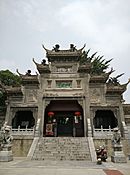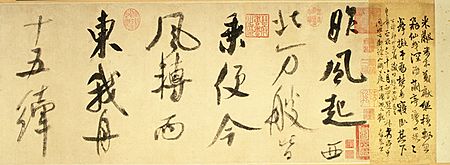Mi Fu facts for kids
Quick facts for kids Mi Fu |
|||||||||||||||||
|---|---|---|---|---|---|---|---|---|---|---|---|---|---|---|---|---|---|

Mi Fu as depicted in a 1107 CE painting by Chao Buzhi
|
|||||||||||||||||
| Chinese name | |||||||||||||||||
| Chinese | 米芾 or 米黻 | ||||||||||||||||
|
|||||||||||||||||
| Korean name | |||||||||||||||||
| Hangul | 미불 | ||||||||||||||||
|
|||||||||||||||||
| Japanese name | |||||||||||||||||
| Hiragana | べいふつ | ||||||||||||||||
|
|||||||||||||||||
Mi Fu (born 1051, died 1107 CE), also known as Mi Fei, was a famous Chinese artist. He was a painter, poet, and calligrapher. Mi Fu was born in Taiyuan during China's Song dynasty. He became well-known for his special way of painting misty landscapes. This style was even named after him, called the "Mi Fu" style. He used large, wet dots of ink applied with a flat brush. His poems were inspired by the great poet Li Bai. His calligraphy was influenced by Wang Xizhi, another famous calligrapher.
Mi Fu is seen as one of the four best calligraphers of the Song dynasty. The others were Su Shi, Hung Tingjian, and Cai Xian. His unique style came from earlier calligraphers, but he added his own special touches.
People thought Mi Fu was quite an unusual person. He was very obsessed with being clean. Sometimes, people even called him "Madman Mi" because he loved collecting stones so much. His son, Mi Youren, also became a famous painter. He followed his father's artistic style.
Mi Fu's Life Story

Mi Fu's mother worked as a midwife and later as a wet-nurse. She even looked after the young Emperor Shenzong of Song. Because of this, Mi Fu knew the royal family. He lived in the special area of the royal palaces.
He started his career working with books. He became a Reviser of Books. Later, he taught painting and calligraphy in the capital city. He also worked as a Secretary for the Board of Rites. He even became a Military Governor in Huaiyang. Mi Fu often spoke out against the usual rules of his time. This caused him to change jobs many times.
As his family's money slowly ran out, Mi Fu started collecting old writings and paintings. The value of his collection grew over time. He also inherited some calligraphy pieces. He kept his collection in two parts. One part was secret, shown only to a few close friends. The other part could be shown to visitors.
In his later years, Mi Fu really liked Holin Temple. It was located on Yellow Crane Mountain. He later asked to be buried near its gate. Today, the temple is gone, but his grave is still there.
Art and Artists in Mi Fu's Time
During Mi Fu's time, landscape painting became very popular. But artists also created other types of art. This included religious figures, birds, flowers, and bamboo paintings. Many highly educated men created this art. For most of them, painting was not their main job. It was a way to show their thoughts about life and nature.
Poetry and writing were often more important to them than painting. These artists usually worked as government officials. If they didn't have family wealth, they made a living this way. Even if they were skilled at ink painting and calligraphy, they avoided being seen as professional artists. They were known as "gentleman-painters."
Artistic activities like calligraphy and painting were seen as hobbies. They were things to do in their free time from official duties. However, their skill came from writing and calligraphy. This allowed them to express their ideas easily. Their art became a very personal way of expression. It was called "idea-writing" later on. The beauty of this art came from how easy it looked to create. But it actually needed a lot of training and deep thought.
Mi Fu was one of these very talented gentleman-painters. He had a sharp eye for art. He also had a good sense of humor and was a skilled writer. He became very important among Chinese art historians. His ideas are still valued today. This is because he wrote about what he saw himself. He didn't just repeat what he heard from others. Mi Fu was brave enough to share his own ideas. This was true even if they were different from what most people thought. His notes about painting and calligraphy are very interesting. They show his own thoughts and ideas. They also help us understand the artists whose works he wrote about.
Mi Fu's Artistic Style

Mi Fu is considered one of the most important artists of the Southern School of landscape painting. However, it's hard to know for sure which paintings are truly his. Many works are said to be by him. Most of them show a certain style that continued for centuries. But it's hard to tell how many were actually created by Mi Fu himself. Because of this, he is remembered more as a skilled calligrapher. He is also known for his influence as an art critic and writer.
For Mi Fu, writing and calligraphy were closely linked to writing poetry or sketching. It needed a sharp mind and spirit. He believed this was best achieved by enjoying wine. Through this, he reached a state of excitement. Mi Fu's friend, Su Shi, admired him greatly. Su Shi wrote that Mi Fu's brush was like a sharp sword used skillfully in a fight. Or like a bow that could shoot an arrow a thousand li (a Chinese unit of distance). It could pierce anything in its way. Su Shi wrote, "It was the highest perfection of the art of calligraphy."
Other art experts said that only Mi Fu could copy the style of the great calligraphers from the Six Dynasties period. Mi Fu's son said that his father always kept a masterpiece of calligraphy. It would be from the Tang or Qin period. He kept it on his desk as a model. At night, he would put it in a box next to his pillow.
Some writings say that Mi Fu did most of his paintings in the last seven years of his life. He himself wrote that he copied the oldest masters. He painted guided by his own talent, not by any teacher. He felt he was representing the loyal men of ancient times.
The paintings that are still known as Mi Fu's show ranges of wooded hills. Or they show cone-shaped mountain peaks rising from layers of misty clouds. At the bottom, there might be water. Closer to the front, there are groups of dark trees. One of the most famous examples of this "Mi Fu style" is a small painting. It is in the Palace Museum and is called Spring Mountains and Pine-Trees. It is the size of a large album page. At the top of the picture, there is a poem. It is said to be by the emperor Emperor Gaozong of Song.
Many pictures said to be by Mi Fu are actually copies. Even if they are painted in a similar way, with a broad, soft brush, they might not be his. They could be from the Southern Song period. Or maybe from the Yuan period. During that time, some leading painters used Mi Fu's style to show their own ideas. Most of these copies are probably from the later Ming period. This was when many people admired Mi Fu greatly. They saw him as the most important artist of the Southern School. Mi Fu himself saw many copies, even of his own works. He saw how rich art lovers spent their money on famous names. They did this instead of buying original artworks. He wrote that they "place their pictures in brocade bags. They give them jade rollers as if they were wonderful treasures. But when they open them, one cannot help but laugh."
Writers who knew Mi Fu or heard about him described his painting style. It is said that he always painted on paper that was not specially prepared. He never painted on silk or on walls. Also, he didn't always use a brush for ink painting. Sometimes he used paper sticks. Or sugar cane after the juice was taken out. He even used a calyx (the outer part) of the lotus flower.
Even though Mi Fu was mostly a landscape painter, he also did portraits. He painted figures in an old-fashioned style. However, he probably spent more time studying old calligraphy and paintings. He spent less time making his own pictures. His book, History of Painting, gives helpful tips. It tells how to properly collect, keep, clean, and frame pictures.
See also
 In Spanish: Mi-Fei para niños
In Spanish: Mi-Fei para niños
- Chinese art
- Chinese painting
- Culture of the Song Dynasty
- History of Chinese art



